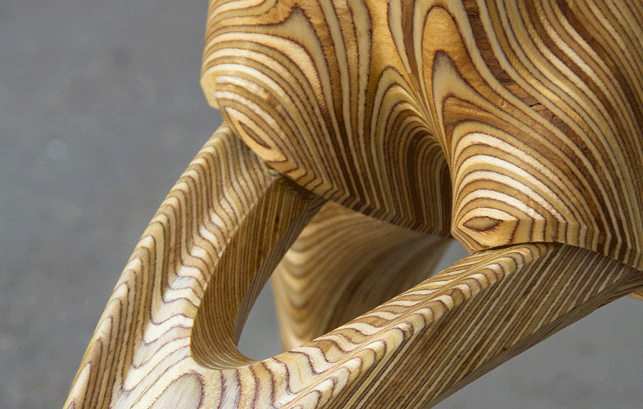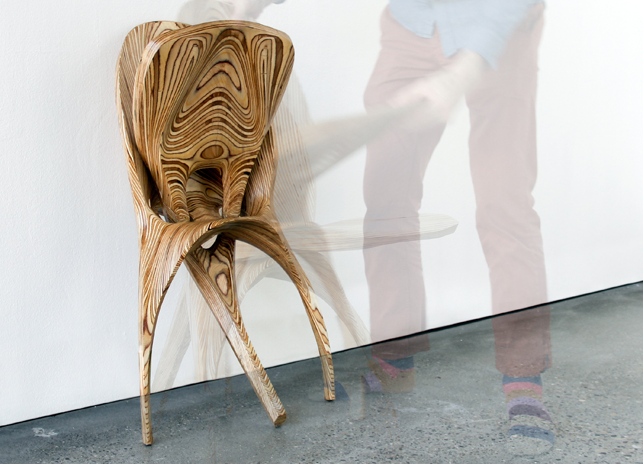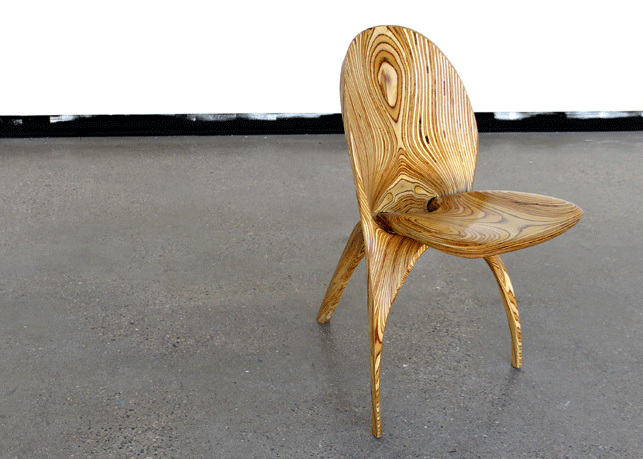In creating his Stratum chair, designer Ammar Kalo drew on a number of sources for inspiration: the sinuous shapes of the human body; rock formations carved out by the sea and wind; and the Art Nouveau style of French architect Hector Guimard.

The Stratum chair’s termination at the ground with three legs accentuates the design’s edginess and gives it a delicate sense of balance
The idea for the chair’s folding hinge, meanwhile, came from studying religious book stands, carved from a single piece of wood with two interlocking parts.
With a background in architecture and post-graduate research work in both digital technologies and material systems, Kalo’s focus is on using the latest technologies to produce distinctive, handcrafted qualities. The Stratum chair is no exception: created from sheets of laminated plywood, the use of 5-axis CNC machining gives it its sharp edges and flowing, uninterrupted curves.
“‘[The Stratum chair’s] unique formal and visual qualities are born out of the ways in which the plywood strata layers are carved to highlight the chair’s functional features,” Kalo says, explaining that this is how the flowing, striated pattern was achieved. “Its termination at the ground with three legs accentuates the design’s edginess and gives it a delicate sense of balance.”

The chair’s folding hinge was inspired by studying religious book stands
The chair was designed in 3D on Rhino, with the Autodesk T-Splines plug-in for Rhino used to add the organic smoothness. Throughout the design process, Kalo produced scaled-down, 3D-printed models of the chair to provide him with a physical reference, using a 3D Systems ProJet 360 printer.
The powder-based material used meant that Kalo could make hand-carved adjustments to his models, helping to refine the overall geometry, before adding the changes back into the CAD model, using T-Splines’ simplified push/pull geometry controls.
The most difficult part of the design process lay in figuring out the interlocking connection detail of the folding hinge. Its swivelling action reduces the space occupied by the chair by half, making storage and shipping easier, but involved multiple studies in terms of design and fabrication.

As the design of the mechanism took shape, MasterCAM X6 was used to program the 5-axis CNC machine. Kalo initially used virtual toolpath tests within the software, so that he could make last-minute changes before starting to physically cut away at the plywood.
In total, the Stratum chair took four months to design and machine. The finished product was hand-finished in Michigan, where Kalo is based, before being exhibited at the SIKKA Art Fair 2015 in Dubai.
Kalo continues to research new fabrication processes using industrial CNC, including 7-axis robotic arms, to create new freedoms in his design process.
ammarkalo.com
.
A beautiful chair inspired by nature and crafted through technology
Default






